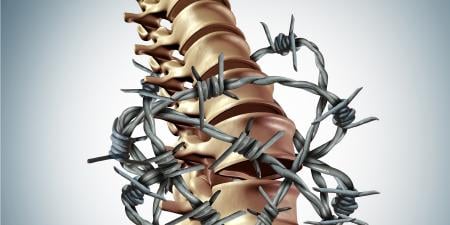Friday 4 O’ Clock in the Pain Clinic
Friday at 4 p.m. our pain clinic phone rang; it was the daughter of one of my patients, crying and telling me that her mother had died following a grueling course of treatment only a year before for widely metastatic breast cancer. The daughter had called me to share the news, saying she was truly grateful for all of the care I had given during her mother’s struggle with intractable cancer pain.
Her mother had been a stoic patient who seldom complained of any symptoms of pain, but I felt she was suffering both physically and emotionally. The patient’s monthly encounters with me were often uneventful, simple, and short exchanges about medications. When I received the phone call from her daughter, I wondered how it was that I was able to make such an impact. I think my patient felt so connected to me and satisfied with her overall care because our relationship was one of good communication and sympathy. The call from her daughter underscored that good communication, both spoken and unspoken, can be the best medicine for our patients.
The Dilemma of Treating Pain
Nearly a third of Americans experience long-lasting pain—the kind that lingers for weeks to months [1]. Chronic pain costs the United States at least $558 billion a year in medical bills, sick days, and lost productivity, which happens to be more than the annual cost of heart disease [2]. All kinds of ailments can trigger lingering pain, from arthritis to cancer, spine problems to digestive disorders, injuries to surgery. Chronic pain can also be a disease all its own. And chronic pain patients feel stigmatized rather than helped by a health care system poorly prepared to treat them [3].
Pain is difficult to treat for a number of reasons. Doctors worry about overprescribing narcotic painkillers, but that is not the only problem they face. Law enforcement efforts to fight the serious problem of prescription drug abuse can be a barrier to pain care. And now restrictive insurance policies may not cover the often costly pain specialist visits and associated treatments. To further muddle the issue, few doctors are trained to manage pain, and most medical students only have a few required didactics on treating it.
Whatever the cause, effective pain management is a moral imperative, and the Institute of Medicine is urging the government, medical groups, and insurers to take a series of steps to transform the field [3].
How Good Communication Can Treat Pain
Communication with patients is therapeutic and has even been shown to be as effective as medications in the management of chronic pain [4]. In my experience, clinicians’ ability to communicate effectively with patients requires more than skill in conducting patient interviews. Assuring patients that you believe they are in pain often nullifies altogether the debate about whether the pain truly exists. Accepting a patient’s pain and frustration without showing irritation or intolerance can yield enormous emotional benefits for patients with painful conditions. I believe many patients have pain without a clear physical cause. The pain is often rooted deeply in conditions that the physician cannot readily see. Being responsive and empathetic helps both the physician and the patient handle the condition positively. These skills allow the physician to understand the patient’s point of view and incorporate it into the treatment [5]. Conversing in this caring, empathetic fashion and engaging in shared decision making with patients also tremendously empowers those who are suffering pain.
There are barriers to effective patient-physician communication, however. The growing demands of clinical productivity [6], increasing paperwork, and electronic medical records encourage clinicians only to check the boxes on the screen [7], which can inhibit effective communication—especially problematic for those with complex chronic pain diagnoses. Developing effective patient-physician communication requires a substantial commitment in an increasingly challenging environment with declining clinical reimbursements and increasing expenses.
Simple Ways to Better Communicate with a Patient in Pain
I follow the Golden Rule in how I treat my patients, and I teach medical students do so the same: do unto others as you would want them to do unto you. It is simple but often forgotten amid the daily complexities of being a physician. Furthermore, it may well be that, in the long term, effective communication skills save time by increasing patient adherence to treatment, reducing the need for follow-up calls and visits. In accordance with the Golden Rule, physicians can take the following steps to improve communication:
- When entering the room of patients in pain, always tell them that you are there to help comfort them and to do your best to relieve their pain.
- Remain calm and show empathy.
- Express concerns for the patient’s feelings.
- Use “I” statements. For example, “I would really like you to take this medication. I want to help you,” versus “You really need to take this medication. We have ordered it for you, because we all care about you.” “You” statements often sound accusatory and can quickly alienate patients by provoking defensiveness and hostility. Use patient-centered interviewing and caring communication skills in daily practice.
- Encourage patients to write down their questions in preparation for appointments. An organized list of questions can facilitate conversation on topics important to the patient. A form for writing down questions can be given to patients on their arrival at the office.
- Advocate for increasing the duration of visits to provide the opportunity to address multiple patient concerns. Increased time for visits is crucial in efforts to improve patient-centered interviewing, shared decision-making, and improved patient-physician communication.
Even though it seems like a physical problem with a purely technical solution, treating the patient is an equally important part of treating pain.
References
-
Brookoff D. Chronic pain: 1. A new disease? Hospital Practice. 2000;35(7):42-59.
- Berwick DM, Hackbarth AD. Eliminating waste in US health care. JAMA. 2012;307(14):1513-1516.
-
Institute of Medicine. Relieving Pain in America: A Blueprint for Transforming Prevention, Care, Education, and Research. Washington, DC: National Academies Press; 2011.
- Kaptchuk TJ, Kelley JM, Conboy LA, et al. Components of placebo effect: randomised controlled trial in patients with irritable bowel syndrome. BMJ. 2008;336(7651):999-1003.
-
Mechanic D, McAlpine DD, Rosenthal M. Are patients’ office visits with physicians getting shorter? N Engl J Med. 2001;344(3):198-204.
- Nutting PA, Rost K, Smith J, Werner JJ, Elliot C. Competing demands from physical problems: effect on initiating and completing depression care over 6 months. Arch Fam Med. 2000;9(10):1059-1064.
- Haas LJ, Leiser JP, Magill MK, Sanyer ON. Management of the difficult patient. Am Fam Physician. 2005;72(10):2063-2068.



